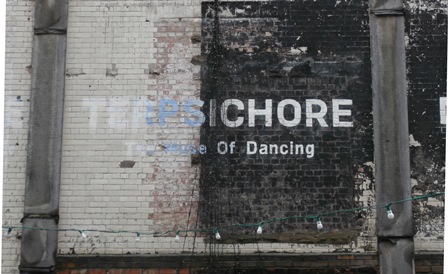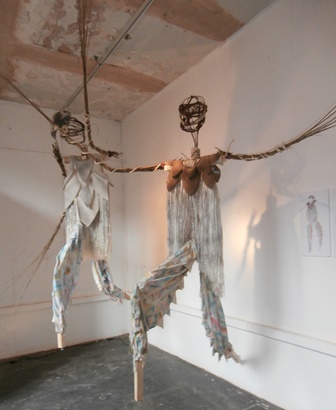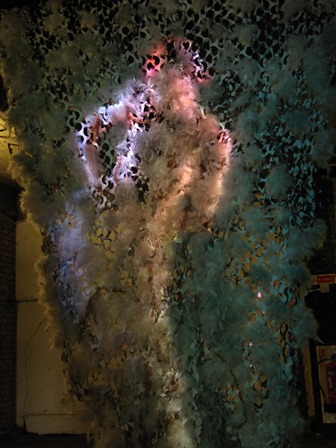5 November 2013, Bargehouse, Oxo Tower Wharf, South Bank, London

Bargehouse is a four-storey warehouse named as it is because, apparently, it used to store the royal barge of James 1. Now it is a an exhibition site and between 25 October and 10 November the home of Ecocentrix, an exhibition focusing on indigeneity in the present day. ‘Performance and provocation in our times’ is its subtitle. (Why the building also has signs identifying each of the muses on one of its exterior walls escapes me for the moment).
I became aware of the exhibition because it was mentioned in Bangarra Dance Theatre’s newsletter for October, which noted that Jacob Nash, resident designer with Bangarra, had recently returned from London where he had an installation in place at the Bargehouse. And indeed Nash’s installation was the highlight of the show. Up on the fourth floor (no lift, narrow staircase) and in a darkened space, a triangular curtain of white feathers hung from the ceiling. The point of this feathered triangle brushed a kind of dance space, a circle outlined with sticks and feathers, on the floor below the hanging. Onto the hanging, film of a dancer performing Stephen Page’s 2011 work Brolga was being projected.
I am sorry that my point and click camera, not to mention my lack of expertise as a photographer in such conditions, was not able to achieve a record of this installation because it was elegant and quite magical with the image of the dancer blurring into the feathers. (See update below)

But Nash and Bangarra weren’t the only Australians represented in the exhibition. On display were several costumes from works by the Broome-based physical theatre company, Marrugeku, whose work often includes stilt-work and aerial choreography. Below are two sea eagle costumes designed by Alice Lau for Buru, Marrugeku’s 2011 work for children.
To complete the Australian representation, a film by Fiona Foley was being screened in another room of the building. With the title Vexed it was made in 2013 and focused on the breakdown of traditional kinship structures as the result of what is referred to as the theft of Aboriginal women by white men at a certain stage in the history of Aboriginal/white relations in Australia. Unlike the Nash installation and the Marrugeku costumes, Foley’s film was strongly political and was accompanied by a text taken from Germaine Greer’s controversial essay On rage. In filmic terms Vexed was distinguished by a technique of overlaying footage upon footage to create trance-like sequences, which on the one hand were in contrast to the power of the message and on the other set up a surreal quality that strengthened the message.
What a pleasure it was to see Australian artists represented in such an influential way in this show.
Michelle Potter, 5 November 2013

Update 7 November 2013:
I was delighted to be contacted by a member of the Ecocentrix team with an image of the Jacob Nash installation. It is a more than difficult situation in which to photograph and the installation itself is a constantly changing one adding further difficulties, but the image above gives an idea of the mystery and magic of Nash’s work.
With thanks to Helen Gilbert.